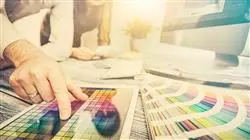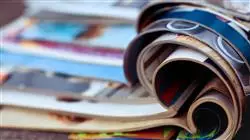University certificate
The world's largest faculty of design”
Description
A complete program that will enable you to work in the different fields of Editorial Design, with specific knowledge of the factors that influence and determine the success of a publication"

Every designer must start their profession with a solid knowledge of the history of design, which will allow them to understand how current trends have been reached and what are the mechanisms that allow a design to be successful and relevant in a particular social, cultural or historical moment.
This concept of general culture will be taken to the territory of audiovisual culture. The graphic design professional needs to know the audiovisual phenomena that move in the same paradigms as graphic communication. The influence of some media on others, the different combinations of media and the new graphic products that incorporate different techniques and approaches from other communicative areas are a knowledge that will open new lines of thought and work.
In this sense, having knowledge in all possible aspects of work is a gateway to very interesting possibilities and new avenues to explore.
Therefore, this program will address the aspects that a designer needs to know in order to plan, develop and finalize any graphic project. An educational path that will scale up the student's competencies to help them achieve the challenges of a top professional.
Graphic design is presented as a viable option for a professional who decides to work independently, but also to be part of any organization or company. An interesting avenue for professional development that will benefit from the specific knowledge that TECH makes available to you.
This program will allow you to enhance your skills and update your knowledge in Editorial Design and Digital Publications"
This professional master’s degree in Editorial Design contains the most complete and up-to-date program on the market. The most important features include:
- Case studies presented by experts
- Graphic, schematic, and highly practical contents
- The latest developments and cutting-edge advances in this area
- Practical exercises where the self-assessment process can be carried out in order to improve learning
- Innovative and highly efficient methodologies
- Theoretical lessons, questions to the expert, debate forums on controversial topics, and individual reflection assignments
- Availability of content from any fixed or portable device with internet connection
A comprehensive analysis of the cultural and aesthetic phenomena that affect the criteria for the creation of graphic communication"
This program is focused on practicing the proposed theoretical learning. Through the most effective teaching systems and contrasting methods imported from the most prestigious universities in the world, the professional will be able to acquire new knowledge in an eminently practical way. In this way, TECH strives to convert its efforts into real and immediate skills.
The online system is another of the strengths of the educational proposal. With an interactive platform that takes advantage of the latest technological developments, TECH offers you the most interactive digital tools. In this way, it offers a form of learning that is totally adaptable to your needs, so that you can perfectly balance this program with your personal or professional life.
A practical and intensive learning that will give you all the tools in ideation, development and creation of any graphic project you need to work in this field"

A program created to allow you to implement the acquired knowledge almost immediately in your daily practice"
Objectives

Our goal is simple: to provide you with the most complete update in techniques and current trends in Editorial Design and Digital Publications, in a Editorial Design fully compatible with your professional and personal obligations"
General Objectives
- Design a graphic development
- Determine the appropriate tools for its development
- Define the most suitable techniques in each graphic communication situation
- Perform the whole process of creating pieces and adapting them to different formats
- Apply final arts
Specific Objectives
Module 1. History of Design
- Have basic knowledge of Human and Social Sciences to be able to plan future research, according to the needs of each design project
- Critically understand the history of artistic practices and contemporary design, the arguments and theoretical assumptions that support them, and the strategies and mechanisms in which they intervene in order to adapt to the new issues and challenges of digital design
- Understand the development of design throughout history as an integration of various disciplines: art, contemporary culture, philosophy, sociology, media history in digital design, linguistics and semiotics
- Develop an evaluative and critical spirit in order to acquire the capacity for analysis and synthesis in the practice and execution of the functions of a designer
- Act as mediators between technology and art, ideas and goals, culture and design
- Understand the relationship between heritage and design, and understand that it is a characteristic of contemporary culture
Module 2. Introduction to Color
- Understand the importance of color in the visual environment
- Acquire the capacity to observe, organize, distinguish between and manage color
- Apply the psychological and semiotic foundations of color in design
- Capture, manipulate and prepare color for its use in physical and virtual supports
- Acquire the ability to form independent judgments through arguments
- Know how to document, by analyzing and interpreting documentary and literary sources with your own criteria
Module 3. Editorial Design
- Know the fundamentals of editorial design in the print and digital context, as well as their interrelation with other areas
- Know the scope and importance of the designer in the editorial field
- Know the specific terminology, techniques and language applied to the design processes: pre-press and printing systems, digital techniques and media, and multimedia
- Design editorial publication taking into account the graphic set and its elements
- Capture, manipulate and prepare text and images for use in different media
- Designing eye-catching visual communications that meet current graphic criteria
- Begin to use Adobe InDesign and learn about the elements available in the program in order to design your own graphic ideas
Module 4. Design Methodology
- Know the basic processes of scientific methodology in the history of design: question states, integral analysis of the design work, problem rethinking, search for unpublished information, hypothesis formulation, critical synthesis processes, orderly formulation of conclusions
- Understand how innovation works as a design driver
- Identify problems related to design, collect and analyze the information required to evaluate and provide solutions according to efficiency criteria: functional, environmental, structural, constructive and expressive in the field of the profession
- Justify ideas by using a coherent and critical argument of the development of a design project
- Gain in-depth knowledge of the dynamics of design management, which allows the application of marketing and business administration knowledge to design projects
- Understand the practice of design as a research method in itself, based on creativity
Module 5. Graphic Design
- Acquire knowledge about the fundamentals of graphic design, as well as its interrelation with other areas: advertising graphic design, editorial design, corporate identity design, web design, packaging design, typographic design, posters, signage, multimedia design, new media design, etc.
- Know the basis, functions and value of graphic design
- Analyze the profile of a graphic designer throughout history and in today's landscape
- Understand the basic and formal elements in graphic design
- Learn which are the most used digital tools in the field of graphic design
- Know and apply basic elements of project organization and management
Module 6. Ethics, Legislation and Professional Deontology
- Be able to gather and interpret relevant data to make judgments that include a reflection on ethical, environmental and social issues
- Carry out professional practice in an ethical manner, respecting the law and in accordance with universal rights
- Develop the learning skills necessary to undertake further studies with a high degree of autonomy
- Understand the professional relationship between designer and client
- Acquire the skills that demonstrate that problems can be solved through argumentation and constructive criticism
- Develop the ability to decide in advance what needs to be done, who needs to do it, and how it should be done
Module 7. Corporate Image
- Capture, manipulate and prepare images for use in different media
- Know the basics of photographic and audiovisual technology
- Gain knowledge about the language and expressive resources of photography and audiovisuals
- Get to know relevant photographic and audiovisual works
- Interrelate formal and symbolic languages with specific functionality
- Handle basic lighting and measuring equipment in photography
- Understand the behavior and characteristics of light and valuing its expressive qualities
Module 8. Typography
- Know the main syntax of graphic language and apply its rules to clearly and precisely describe objects and ideas
- Know the origin of letters and their historical importance
- Recognize, study and apply typography to graphic processes in a coherent way
- Know and apply the fundamental aesthetics of typography
- Know how to analyze the layout of texts in the design object
- Be able to carry out professional work starting from typesetting
Module 9. Layout
- Design editorial publication taking into account the graphic set and its elements
- Know the task of a layout designer and the importance of their role in the publishing field
- Gain knowledge about digital media and their importance in the current context
- Use Adobe InDesign for the proper development of graphic projects
- Use social networks from an artistic perspective, with an awareness of the importance of a good graphic strategy
- Develop an editorial language to advertise a product or service, with a clear and specific purpose
Module 10. Final Art
- Know the specific terminology, techniques and language applied to the design processes: pre-press and printing systems, digital techniques and media, and multimedia
- Gain knowledge about the printing systems in order to be able to assess which is the best alternative when it comes to physically capture a graphic project
- Learn about printing alternatives that are governed by sustainability principles and to use them in the process of conceiving a design project from scratch
- Learn the procedures to be followed to properly prepare a final artwork for printing
- Get to know what binding is and to learn more about the different types of bindings
- Incorporate the necessary technical vocabulary to achieve a fluent communication with the technicians and sectors involved in the edition

Include in your specialization the knowledge of the most advanced tools in Editorial Design and bring to your work in this field the avant-garde you need to compete at the forefront"
Professional Master's Degree in Editorial Design
Editorial design is one of the oldest disciplines in the creation of communicative pieces, its evolution over the years has provided different formulas for success that allow the professional to perform ideally and connect with the consumer in an optimal way. The Professional Master's Degree in Editorial Design at TECH Global University is presented as an excellent opportunity for academic qualification, because we have high quality multimedia educational content, which will allow applicants to create a new conceptual background in the latest innovations and trends in the editorial field. In addition, the new skills obtained will enable them to design and lead the creation of communicative pieces based on market guidelines and customer desires.
Postgraduate Certificate in Editorial Design 100% online
TECH's postgraduate course will allow students to develop projects for the creation of traditional media such as books, newspapers, magazines, as well as digital products focused on web design, an aspect that is the main focus of distribution today. Similarly, focusing on improving the practical skills of students, we have a state-of-the-art audiovisual teaching system, through which they will solve simulated situations based on real life. In this way, applicants will be prepared for the different challenges and problems they will face during their professional practice, while at the same time they will easily and quickly internalize the thematic axes taught throughout the Postgraduate Certificate.







